Gallery
- Mainland East Asia in 1616
- Mainland East Asia in 1688
- Mainland East Asia in 1757
- Dzungar–Qing Wars (1687–1757)
This is a timeline of the Oirats , also known as the Kalmyks or Dzungars.
| Year | Date | Event |
|---|---|---|
| 6TH - 8TH | ÖLÜ-T or YELÜ-T IN THE EAST. According to Erdeniyin Tobchi (17 century), ÖLÜ-T or YELÜ-T (-t for plural) was one of the leading familial lineages in the Oirat coalition. The first documented reference to ÖLÜ-T (YELÜ-T) was Onginsk "rune" inscriptions dated in the 6th century. [1] The political elite in the Rouran and Tobgach empires were the YELÜ-T Mongolic speakers. Although these two empires encompassed multilingual populations, the language of diplomacy, trade, and culture was a ÖLÜ (YELÜ) dialect of ancient Mongolic descent. [2] ÖLÜ-T or YELÜ-T IN THE CASPIAN STEPPES, 6th - 8th century The YELÜ-AVARS, originally hailing from Mongolia, established their formidable empire known as the Rouran Khanate (330-555 CE). [3] However, in the midst of the sixth century, they faced destruction at the hands of the Turks, who pursued them as far as the Caucasus region. [4] This displacement triggered a series of events. Settling in the Caucasus around 558, the Mongolic Avars intervened in Germanic tribal conflicts, forming alliances such as with the Lombards to overthrow the Gepidae, who were Byzantine allies. Between 550 and 575, they solidified their presence by establishing the Avar Khanate (6th to 8th century) in the Hungarian plain, situated between the Danube and Tisza rivers. [4] |
| Year | Date | Event |
|---|---|---|
| 1207 | Jochi, Genghis Khan's oldest son, subjugates the 'forest peoples' - Oirat, Kyrgyz, and Buryat [5] | |
| 1207-1208 | Quduqa Bäki, the leader of the Oirats, becomes a QUDA ally, or in-law familial lineage to Genghis Khan and his imperial lineage. Genghis Khan marries his daughter Checheyiken and Jochi's daughter Holuiqan to two Quduqa Bäki's sons [6] | |
| 1217-1336 | Oirats were prominent in the Middle Eastern Il-Khanate, whose founder Hulegu married two Oirat women in succession [6] TURKEY. An Oirat tümen under the Il-Khans’ kürgens (son-in-laws) settled in the area of Diyarbakır. EGYPT. In 1296, this tümen moved to MAMLUK EGYPT when GHAZAN KHAN favored their local Turkmen rivals. By 1336, Ali-Padshah, a member of the Oirat ruling family, was a contender for power in the disintegrating Il- Khanate. KHORASAN. Arghun Aqa, a famous Oirat bureaucrat, became governor of Khorasan (eastern Iran) and founder of a prominent Oirat family there. [6] | |
| 1260-1264 | Oirats had strong QUDA ties to the families of Jochi’s sons Hordu and BATU. They also were QUDA to QUBILAI KHAN’s brother ARIQ-BÖKE (d. 1266) and his descendants, whose territory bordered on the Oirats’. [6] Toluid Civil War : The Four Oirat (Choros, Torghut, Dörbet, and Khoid) is formed in support of Ariq Böke against Kublai Khan [7] |
| Year | Date | Event |
|---|---|---|
| 1388 | Jorightu Khan Yesüder, a descendant of Ariq Böke, kills Uskhal Khan Tögüs Temür and occupies the Northern Yuan throne with the backing of the Oirats [8] | |
| 1399 | The Four Oirat break away from Northern Yuan [9] |
| Year | Date | Event |
|---|---|---|
| 1414 | April | Second Mongol Campaign : Ming forces engage Oirats at the Tuul River, suffering heavy casualties, but ultimately prevail through the use of heavy cannon bombardments [10] |
| 1423 | August | Fourth Mongol Campaign : The Yongle Emperor launches an offensive against Arughtai only to find out he had already been defeated by the Oirats [11] |
| 1433 | The Oirats install Taisun Khan as leader of the Eastern Mongols [9] | |
| 1449 | July | Tumu Crisis : Esen Taishi of the Oirats and de facto ruler of the Northern Yuan launches an invasion of the Ming dynasty [12] |
| 4 August | Tumu Crisis : The Zhengtong Emperor departs from Beijing to personally confront Esen Taishi [13] | |
| 30 August | Tumu Crisis : The Ming rearguard is defeated [14] | |
| 1 September | Tumu Crisis : The Ming army is annihilated and the Zhengtong Emperor is captured by Esen Taishi [15] | |
| 27 October | Esen Taishi lays siege to Beijing but fails to take it and withdraws after 5 days [16] | |
| 1451 | Esen Taishi declares himself Yuan Emperor, which causes widespread dissent among his followers [9] | |
| 1454 | Esen Taishi is killed and the Northern Yuan is once more split into two portions between the Oirats and Eastern Mongols [17] | |
| 1457 | The Oirats invade the Uzbek Khanate and defeat Abu'l-Khayr Khan, plundering the cities on the Syr Darya [18] | |
| 1469 | The Oirats occupy Mobei [19] | |
| 1472 | The Oirats invade Moghulistan and defeat Yunus Khan [20] | |
| 1480 | Dayan Khan pushes the Oirats westward [19] |
| Year | Date | Event |
|---|---|---|
| 1507-82 | Altan Khan expels the Oirats from Mongolia [21] | |
| 1587 | Kharkhul repels an attack by Ubasi Khong Tayiji [22] |
| Year | Date | Event |
|---|---|---|
| 1607 | Oirat emissaries reach the Russians at Tara [23] | |
| 1608 | A group of Khoshut Oirats raid the Nogai Horde [24] | |
| 1616 | The first Russian embassy reaches the Oirats [21] | |
| 1620 | Kharkhul of the Choros clan attacks Ubasi Khong Tayiji but is defeated and the Oirats are forced to retreat into Siberia [25] | |
| 1622 | Oirats lay siege to Kuznetsk but fail to take it [26] | |
| 1623 | Kharkhul unites the Four Oirat and defeat Ubasi Khong Tayiji [25] | |
| 1625 | Kalmyk Khanate : The Torghut chieftain Kho Orluk moves 50,000 families west [27] | |
| 1628 | Kalmyk Khanate : The Kalmyks attack the Nogai Horde, displacing them [28] | |
| 1634 | Dzungar Khanate : Kharkhul dies and is succeeded by his son Erdeni Batur, who establishes the Dzungars on the upper Emil River south of the Tarbagatai Mountains [29] | |
| 1636 | Güshi Khan of the Khoshut responds to a Gelug invitation and invades Qinghai with 10,000 troops [29] | |
| 1637 | Güshi Khan kills Choghtu Khong Tayiji and proceeds to invade Tibet [29] | |
| 1642 | Khoshut Khanate : Güshi Khan conquers Tibet and bestows supreme authority over the region to the 5th Dalai Lama, who reciprocates by granting him the title of Chogyal (Dharma King) [29] | |
| 1644 | Kalmyk Khanate : Kho Orluk is killed while pursuing the fleeing Nogais and is succeeded by Shukhur Daichin [27] | |
| 1646 | Shukhur Daichin, Erdeni Batur and Güshi Khan send tribute to the Qing dynasty [22] | |
| 1651 | Kalmyk Khanate : The Kalmyks inflict a massive defeat on the Crimean Khanate and Nogais [24] | |
| 1653 | Dzungar Khanate : Erdeni Batur dies and is succeeded by his son Sengge [30] | |
| 1661 | Kalmyk Khanate : Shukhur Daichin is succeeded by Puntsug [31] | |
| 1667 | Dzungar Khanate : Dzungars and Khakas defeat a Russian force and lay siege to Krasnoyarsk, reducing its inhabitants to starvation; Sengge defeats Erinchin Lobsang Tayiji [26] | |
| 1668 | Kalmyk Khanate : Puntsug joins the Russians in attacking the Crimean Khanate [27] | |
| 1670 | Kalmyk Khanate : Puntsug is succeeded by Ayuka Khan [31] | |
| 1671 | Dzungar Khanate : Sengge is assassinated and succeeded by his younger brother Galdan Boshugtu Khan [30] | |
| 1678 | Dzungar conquest of Altishahr : Ismail Khan drives out to the Aq Taghliq Khoja Afaq Khoja, who seeks help from the 5th Dalai Lama, who in turn writes a letter to the Dzungar Khanate for help. [32] | |
| 1679 | Dzungar conquest of Altishahr : Galdan Boshugtu Khan conquers Hami and Turpan [30] | |
| 1680 | Dzungar conquest of Altishahr : Galdan Boshugtu Khan conquers Kashgar, Yarkand, and Khotan, killing Ismail's family. Abd ar-Rashid Khan II is installed as ruler. [33] | |
| 1682 | Dzungar Khanate : Riots break out, forcing Abd ar-Rashid Khan II to flee; his brother Muhammad Imin Khan succeeds him [34] | |
| 1684 | Dzungar Khanate : Galdan Boshugtu Khan takes Tashkent and Sairam [30] | |
| 1686 | Dzungar Khanate : Galdan Boshugtu Khan attacks Andijan [30] | |
| 1688 | Dzungar–Qing Wars : Galdan Boshugtu Khan invades Mongolia with 30,000 troops and defeats the Tüsheet Khan Chikhundorj, annexing the region [35] | |
| 1689 | Dzungar Khanate : While Galdan Boshugtu Khan was at war, his nephew Tsewang Rabtan seized the throne in Dzungaria [35] | |
| 1690 | 3 September | Battle of Ulan Butung : Galdan Boshugtu Khan leads 20,000 troops into battle with a Qing army 300 km north of Beijing, ending with Dzungar withdrawal [35] |
| 1693 | Dzungar Khanate : Muhammad Imin Khan attacks the Dzungars but is overthrown by Afaq Khoja, whose son Yahiya Khoja is enthroned [34] | |
| 1695 | Dzungar Khanate : Afaq Khoja and Yahiya Khoja are killed in a rebellion [34] | |
| 1696 | Battle of Jao Modo : The Qing dynasty invades Mongolia with 100,000 troops in three columns. Galdan Boshugtu Khan suffers defeat against the Western Route Army but manages to escape. [35] | |
| Dzungar Khanate : Akbash Khan is enthroned but the begs of Kashgar refuse to acknowledge him. Dzungar troops are brought in by Akbash to enforce his rule. However the Dzungars install Mirza Alim Shah Beg; so ends the Yarkent Khanate and Chagatai rule. [36] | ||
| 1697 | 4 April | Dzungar–Qing Wars : Galdan Boshugtu Khan dies in the Altai Mountains [35] |
| Dzungar–Qing Wars : ʿAbdu l-Lāh Tarkhān Beg rebels against the Dzungar Khanate in Hami [37] | ||
| 1698 | Dzungar–Qing Wars : Qing dynasty occupies Hami [38] |
| Year | Date | Event |
|---|---|---|
| 1710 | Dzungar Khanate : Dzungars demolish a Russian fort on the Biya River [39] | |
| 1717 | Khoshut Khanate : The Dzungars invade and kill Lha-bzang Khan, ending the Khoshut Khanate [40] | |
| 1720 | Chinese expedition to Tibet (1720) : The Qing dynasty expels the Dzungars from Tibet, beginning the period of Tibet under Qing rule [40] | |
| Dzungar–Qing Wars : Amin Khoja leads a rebellion in Turpan against the Dzungar Khanate and defects to the Qing dynasty [38] | ||
| 1724 | Kalmyk Khanate : Ayuka Khan is succeeded by Tseren Donduk Khan [31] | |
| 1727 | Dzungar Khanate : Tsewang Rabtan dies and is succeeded by his son Galdan Tseren [40] | |
| 1732 | Dzungar–Qing Wars : The Dzungars attack Amin Khoja, who takes his people to settle in Guazhou [38] | |
| 1735 | Kalmyk Khanate : Tseren Donduk Khan is succeeded by Donduk Ombo Khan [31] | |
| 1737 | Dzungar–Qing Wars : Abuse by the Dzungars cause residents of the Tarim Basin to flee to the Qing dynasty [37] | |
| 1741 | Kalmyk Khanate : Donduk Ombo Khan is succeeded by Donduk Dashi Khan [31] | |
| 1745 | Dzungar Khanate : Galdan Tseren dies and is succeeded by his son Tsewang Dorji Namjal [41] | |
| 1750 | Dzungar Khanate : Tsewang Dorji Namjal is overthrown by his cousin Lama Dorji [41] | |
| 1752 | Dzungar Khanate : Dawachi takes control of the khanate with the aid of Amursana [42] | |
| 1754 | Dzungar–Qing Wars : The Dörbet and Amursana defect to the Qing dynasty [42] | |
| 1755 | Dzungar–Qing Wars : The Qing dynasty sends 50,000 troops in two columns against the Dzungars, meeting little resistance, and complete the destruction of the khanate in just 100 days, however Amursana revolts in the aftermath [38] | |
| 1757 | Amursana flees the Qing dynasty, dying in Tobolsk [42] | |
| 1761 | Kalmyk Khanate : Donduk Dashi Khan is succeeded by Ubashi Khan [31] | |
| 1771 | Kalmyk Khanate : Ubashi Khan leads 170,000 Kalmyks on a return migration to Dzungaria with less than 70,000 reaching their destination where they are received as Qing subjects; after failing to stop the Kalmyk migration, Catherine the Great abolishes the khanate [43] |

The Dzungar Khanate, also written as the Zunghar Khanate or Junggar Khanate, was an Inner Asian khanate of Oirat Mongol origin. At its greatest extent, it covered an area from southern Siberia in the north to present-day Kyrgyzstan in the south, and from the Great Wall of China in the east to present-day Kazakhstan in the west. The core of the Dzungar Khanate is today part of northern Xinjiang, also called Dzungaria.

The Tarim Basin is an endorheic basin in Xinjiang, Northwestern China occupying an area of about 888,000 km2 (343,000 sq mi) and one of the largest basins in Northwest China. Located in China's Xinjiang region, it is sometimes used synonymously to refer to the southern half of the province, that is, Southern Xinjiang or Nanjiang, as opposed to the northern half of the province known as Dzungaria or Beijiang. Its northern boundary is the Tian Shan mountain range and its southern boundary is the Kunlun Mountains on the edge of the Tibetan Plateau. The Taklamakan Desert dominates much of the basin. The historical Uyghur name for the Tarim Basin is Altishahr, which means 'six cities' in Uyghur. The region was also called Little Bukhara or Little Bukharia.

The Chagatai Khanate, or Chagatai Ulus was a Mongol and later Turkicized khanate that comprised the lands ruled by Chagatai Khan, second son of Genghis Khan, and his descendants and successors. At its height in the late 13th century the khanate extended from the Amu Darya south of the Aral Sea to the Altai Mountains in the border of modern-day Mongolia and China, roughly corresponding to the area once ruled by the Qara Khitai.
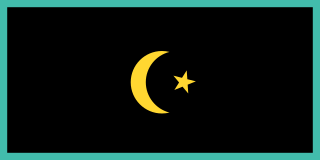
The Khanate of Khiva was a Central Asian polity that existed in the historical region of Khwarezm in Central Asia from 1511 to 1920, except for a period of Afsharid occupation by Nader Shah between 1740 and 1746. Centred in the irrigated plains of the lower Amu Darya, south of the Aral Sea, with the capital in the city of Khiva. It covered present-day western Uzbekistan, southwestern Kazakhstan and much of Turkmenistan before the Russian arrival at the second half of the 19th century.

Moghulistan, also called the Moghul Khanate or the Eastern Chagatai Khanate, was a Mongol breakaway khanate of the Chagatai Khanate and a historical geographic area north of the Tengri Tagh mountain range, on the border of Central Asia and East Asia. That area today includes parts of Kazakhstan, Kyrgyzstan, and northwest Xinjiang, China. The khanate nominally ruled over the area from the mid-14th century until the late 17th century.

Nomadic empires, sometimes also called steppe empires, Central or Inner Asian empires, were the empires erected by the bow-wielding, horse-riding, nomadic people in the Eurasian Steppe, from classical antiquity (Scythia) to the early modern era (Dzungars). They are the most prominent example of non-sedentary polities.
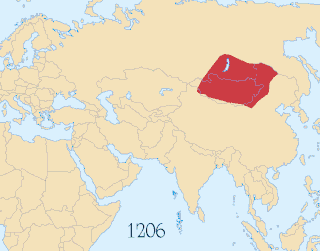
This is the timeline of the Mongol Empire from the birth of Temüjin, later Genghis Khan, to the ascension of Kublai Khan as emperor of the Yuan dynasty in 1271, though the title of Khagan continued to be used by the Yuan rulers into the Northern Yuan dynasty, a far less powerful successor entity, until 1634.

The Northern Yuan was a dynastic regime ruled by the Mongol Borjigin clan based in the Mongolian Plateau. It existed as a rump state after the collapse of the Yuan dynasty in 1368 and lasted until its conquest by the Jurchen-led Later Jin dynasty in 1635. The Northern Yuan dynasty began with the retreat of the Yuan imperial court led by Toghon Temür to the Mongolian steppe. This period featured factional struggles and the often only nominal role of the Great Khan.

The Tang dynasty in Inner Asia was the expansion of the Tang dynasty's realm in Inner Asia in the 7th and, to a lesser degree, the 8th century AD, in the Tarim Basin, the Mongolian Plateau, and portions of Central Asia. Wars were fought against the Gokturk Empires and Xueyantuo, but also against many states of Central Asia. This expansion was not steady; for example, the Tang did lose control of the Tarim Basin temporarily to the Tibetan Empire in the 680s, and their expansion north of the Gobi Desert was thwarted in 682. Emperor Taizong's military success was, in part, a consequence of changes he initiated in the Chinese army, including improved weaponry. The emperor placed a new emphasis on cavalry, which was very important because his non-Han opponents used the horse effectively in warfare.
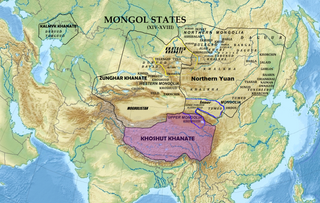
The Khoshut Khanate was a Mongol Oirat khanate based in the Tibetan Plateau from 1642 to 1717. Based in modern Qinghai, it was founded by Güshi Khan in 1642 after defeating the opponents of the Gelug school of Tibetan Buddhism in Tibet. The 5th Dalai Lama established a civil administration known as Ganden Phodrang with the aid of Güshi Khan. The role of the khanate in the affairs of Tibet has been subject to various interpretations. Some sources claim that the Khoshut did not interfere in Tibetan affairs and had a priest and patron relationship between the khan and Dalai Lama while others claim that Güshi appointed a minister, Sonam Rapten, as de facto administrator of civil affairs while the Dalai Lama was only responsible for religious matters. In the last years of the khanate, Lha-bzang Khan murdered the Tibetan regent and deposed the 6th Dalai Lama in favor of a pretender Dalai Lama.

The Yarkent Khanate, also known as the Yarkand Khanate and the Kashghar Khanate, was a Sunni Muslim Turkic state ruled by the Mongol descendants of Chagatai Khan. It was founded by Sultan Said Khan in 1514 as a western offshoot of Moghulistan, itself an eastern offshoot of the Chagatai Khanate. It was eventually conquered by the Dzungar Khanate in 1705.

This is a timeline of the Tang dynasty, which covers a period of roughly 289 years, from 618, when the dynasty was founded, to 907, when the last Tang emperor was deposed by the warlord Zhu Wen, who established the Later Liang dynasty, inaugurating the period of Five Dynasties and Ten Kingdoms. Information on areas and events relevant to the Tang dynasty such as the Wu interregnum, when Wu Zetian established her own Zhou dynasty, and other realms such as the Sui dynasty, Tibetan Empire, Three Kingdoms of Korea, Nanzhao, Japan and steppe nomads are also included where necessary.

This is a timeline of the Karluks. The Kara-Khanid Khanate is also included; however, it is disputed whether the Karluks or Yagmas were the dominant group within the khanate.
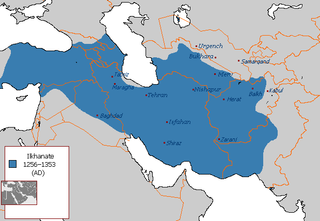
This is a timeline of the Ilkhanate.

This is a timeline of the Chagatai Khanate (1226–1348) and its successor states, Moghulistan (1347–1462), Yarkent Khanate (1514–1696), and the Turpan Khanate (1462–1680).
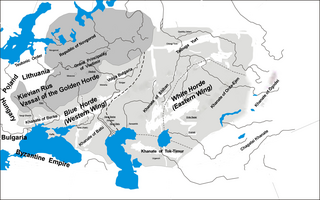
This is a timeline of events involving the Golden Horde (1242–1502), from 1459 also known as the Great Horde.

This is a timeline of the Qing dynasty (1644–1912).

This is a timeline of the Northern Yuan dynasty.

This is a timeline of the Xinjiang under the rule of the Qing dynasty.
This is a timeline of the Uzbeks.